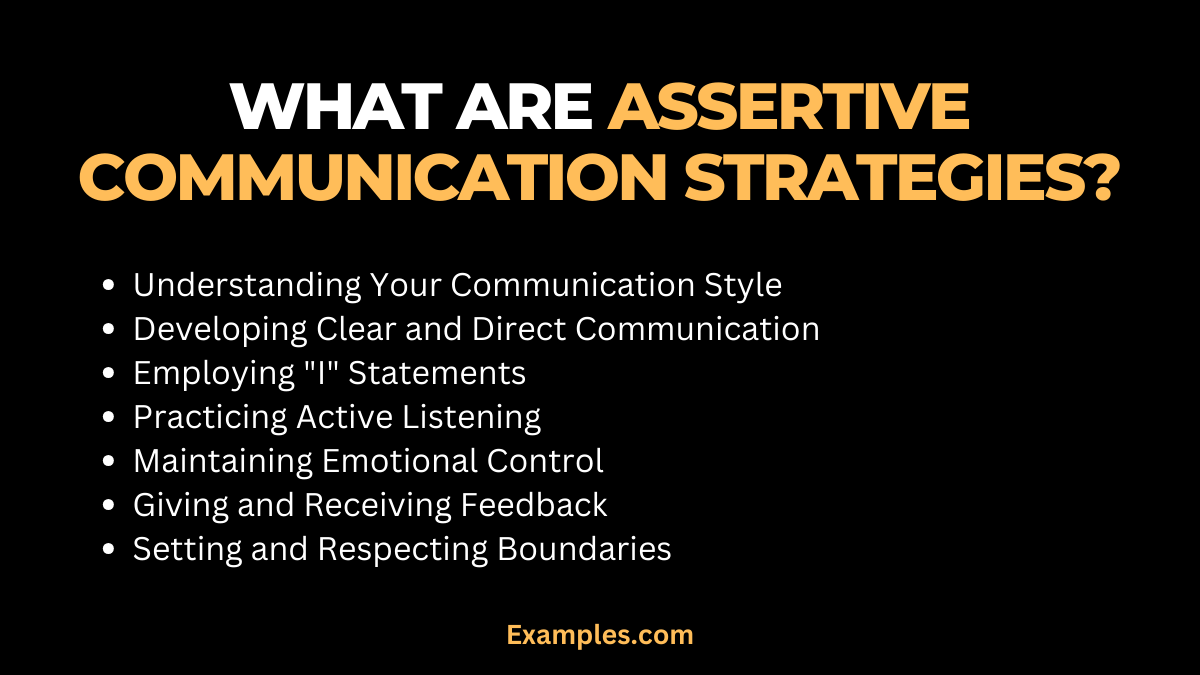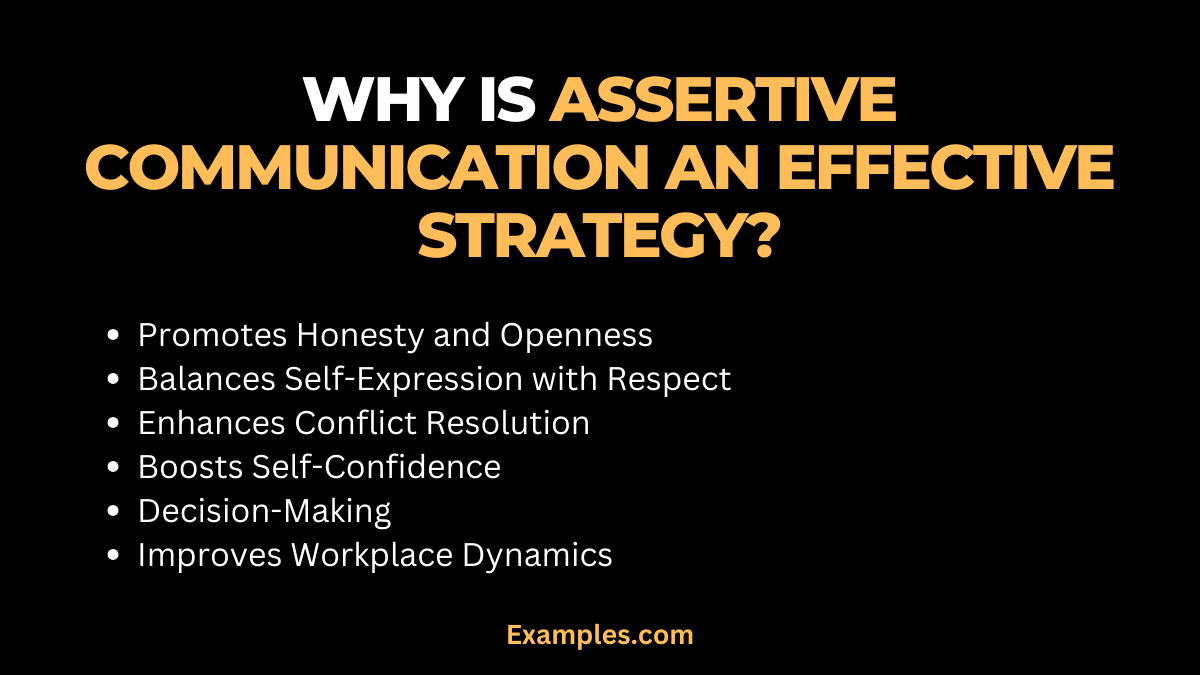Assertive Communication Strategies
Navigating the art of assertive communication can be transformative. Our guide offers a deep dive into assertive communication strategies, enriched with practical communication examples. Learn to articulate your thoughts confidently and respectfully, balancing firmness with empathy. We explore various techniques like active listening, clear expression, and emotional control, each illustrated with real-world scenarios. Whether in personal relationships or professional settings, these strategies will empower you to communicate effectively, maintaining both self-respect and respect for others. Join us on this journey to master assertive communication for impactful and positive interactions.
What are Assertive Communication Strategies?

Assertive communication strategies are techniques used to express oneself openly and directly while respecting the rights and opinions of others. These strategies involve using clear language and respectful tone to convey messages in a confident, yet non-confrontational manner. They include actively listening to others, expressing needs and desires clearly, using “I” statements to speak from personal experience, and setting healthy boundaries. These strategies aim to create a balance in communication where all parties feel heard and respected, leading to more effective and harmonious interactions.
Key Strategies for Assertive Communication:
Assertive communication is a critical skill for effective interpersonal interactions. Here are some key strategies:
Understanding Your Communication Style
- Self-Reflection: Recognize your natural communication tendencies.
- Awareness: Understand how your style affects others.
Developing Clear and Direct Communication
- Clarity: Be clear and concise in your message.
- Directness: Speak straightforwardly without being aggressive.
Employing “I” Statements
- Personal Ownership: Use “I” statements to express your feelings and needs.
- Avoiding Blame: Prevent accusatory tones by focusing on your perspective.
Practicing Active Listening
- Attentive Listening: Truly listen to understand, not just to respond.
- Empathetic Response: Show empathy and acknowledgment of others’ viewpoints.
Maintaining Emotional Control
- Calmness: Stay composed, even in challenging conversations.
- Emotion Regulation: Manage your emotions effectively for clear communication.
Giving and Receiving Feedback
- Constructive Feedback: Offer feedback that is helpful and specific.
- Receptive to Criticism: Be open to receiving feedback without defensiveness.
Setting and Respecting Boundaries
- Boundary Setting: Clearly define and communicate your limits.
- Respect for Others: Honor the boundaries of others as well.
By incorporating these assertive communication strategies, individuals can communicate more effectively, ensuring that their message is conveyed respectfully and clearly, while also valuing the perspectives and boundaries of others.
Why is Assertive Communication An Effective Strategy?

Assertive communication is a highly effective strategy for several reasons:
Promotes Honesty and Openness
- Fosters Transparency: Being assertive allows individuals to express their thoughts and feelings openly, leading to more transparent interactions.
- Builds Trust: Open and honest communication cultivates trust among individuals, essential for healthy relationships.
Balances Self-Expression with Respect
- Respects Boundaries: Assertiveness involves respecting one’s own boundaries and those of others, promoting mutual respect.
- Encourages Mutual Understanding: This balance aids in understanding different perspectives without overstepping or undermining each other.
Enhances Conflict Resolution
- Reduces Misunderstandings: Clear, direct communication minimizes the chances of misunderstandings that can lead to conflicts.
- Solves Problems Effectively: Assertive communicators tend to address issues head-on, leading to quicker and more effective problem-solving.
Boosts Self-Confidence and Decision-Making
- Empowers the Individual: Practicing assertiveness can significantly boost an individual’s self-confidence.
- Improves Decision-Making: Confident individuals are more likely to make clear, decisive decisions.
Improves Workplace Dynamics
- Enhances Team Collaboration: In a professional setting, assertiveness leads to better collaboration and teamwork.
- Increases Productivity: Clear communication and effective problem-solving ultimately contribute to higher productivity and a more positive work environment.
Incorporating assertive communication strategies in daily interactions leads to more honest, respectful, and productive conversations, both in personal and professional contexts.
What are the Steps of Assertive Communication Strategies?
Step 1: Self-Reflection
- Identify Your Needs: Understand your own needs, feelings, and goals before engaging in a conversation.
- Emotional Awareness: Recognize and regulate your emotions to communicate effectively.
Step 2: Clear Expression
- Use ‘I’ Statements: Express your thoughts and feelings by starting sentences with ‘I’ to own your message.
- Be Specific and Direct: Clearly articulate your point without ambiguity.
Step 3: Active Listening
- Empathetic Engagement: Show genuine interest in understanding the other person’s perspective.
- Validating Responses: Acknowledge and validate the other party’s feelings and views.
Step 4: Body Language
- Non-Verbal Cues: Use open and confident body language to reinforce your words.
- Maintain Appropriate Eye Contact: Establish trust and connection through balanced eye contact.
Step 5: Respectful Interaction
- Consideration for Others: Respect the opinions and boundaries of others while asserting your own.
- Constructive Feedback: Offer feedback that is helpful and specific, avoiding criticism or blame.
Step 6: Setting Boundaries
- Define Limits: Clearly communicate your limits and boundaries.
- Firm Yet Flexible: Be firm in your stance but open to negotiation and compromise.
These steps are crucial in mastering assertive communication strategies, ensuring you communicate your needs and opinions effectively while maintaining respectful and productive interactions.
How to Use Assertive Communication Strategies and Techniques?
Implementing assertive communication strategies and techniques involves several key steps:
Understanding Your Needs
- Self-Awareness: Be clear about your own needs, desires, and boundaries.
- Honest Self-Expression: Express your thoughts and feelings honestly without aggression or passivity.
Active Listening
- Attentive Listening: Pay close attention to others’ words and nonverbal cues.
- Empathetic Response: Show empathy and understanding of others’ perspectives.
Clear and Direct Language
- Concise Communication: Use clear, straightforward language to convey your message.
- Non-Aggressive Tone: Maintain a calm and non-threatening tone of voice.
Body Language and Nonverbal Cues
- Confident Posture: Use open and confident body language.
- Appropriate Eye Contact: Maintain eye contact that is neither intimidating nor evasive.
Setting Boundaries
- Firm Boundaries: Clearly define and communicate your personal boundaries.
- Respect for Others: Respect the boundaries and rights of others in your interactions.
Conflict Resolution
- Constructive Feedback: Provide feedback in a way that is constructive, not critical.
- Problem-Solving Approach: Focus on finding mutually beneficial solutions.
By incorporating these strategies into your daily interactions, you can effectively use assertive communication to enhance both personal and professional relationships.
Tips for Improving Assertive Communication Strategies
Assertive communication is not just about what you say, but also how you say it. Here are some effective tips to enhance your assertive communication strategies:
Practice Active Listening
- Engage Fully: Show genuine interest in the speaker’s words.
- Reflect and Clarify: Summarize and ask clarifying questions to ensure understanding.
Use ‘I’ Statements
- Express Yourself Clearly: Use ‘I’ statements to express your thoughts and feelings without blaming or accusing others.
Maintain Appropriate Body Language
- Non-Verbal Cues: Ensure your body language matches your words, using open gestures and maintaining eye contact.
Control Your Emotions
- Stay Calm: Manage your emotions to keep the conversation respectful and productive.
Provide Constructive Feedback
- Focus on Improvement: Offer feedback that is specific and actionable, aimed at improvement.
Set Clear Boundaries
- Define Limits: Clearly communicate your limits and respect others’ boundaries.
By incorporating these tips, you can significantly improve your assertive communication strategies, ensuring your interactions are both effective and respectful.
In conclusion, mastering assertive communication strategies is not just about improving your interactions; it’s about enhancing your overall quality of life. By adopting these techniques, you can navigate complex conversations with ease, establish healthy boundaries, and build stronger, more respectful relationships. Whether it’s in a professional environment or personal life, assertive communication paves the way for a more confident, clear, and empathetic exchange of ideas. It’s a skill that fosters mutual understanding and respect, making every conversation a step towards more effective and meaningful connections.
To further explore the nuances of assertive communication and its impact, consider visiting the American Psychological Association for a deeper understanding of psychological perspectives on assertiveness. Additionally, for those interested in professional development, MindTools offers a range of resources and tools to help refine communication skills in a business context. These resources provide valuable insights and practical advice, enhancing your journey in becoming an adept assertive communicator.



